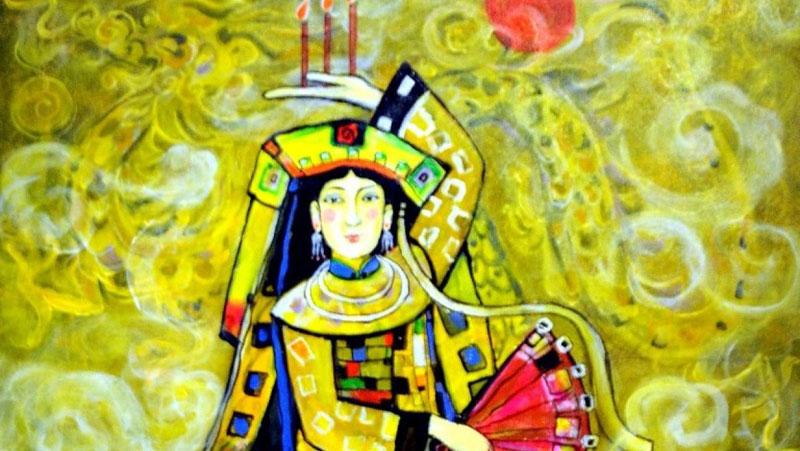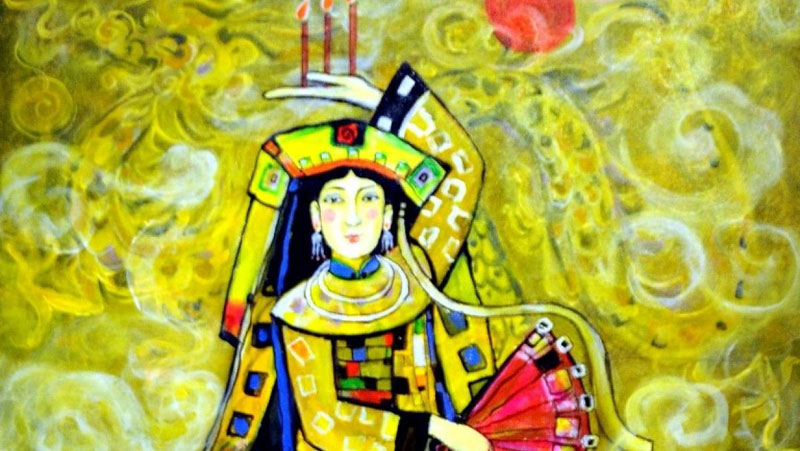
Nearly 100 paintings on the theme of ‘hau dong’ (spirit mediumship) are on display at an exhibition that opened in Hanoi on May 21.

A painting on display
at the exhibition
Utilising various genres of media, the 24 participating
artists convey their different views on the traditional Vietnamese religious
practice through their paintings.
Painter Le Hai, who brought two paintings to the event,
shared that he was excited to take part in the exhibition as ‘hau dong’ is
quite a new theme for most artists. However, he also found that it was a tough
task to deal with the abstract concept of the practice.
The topic requires the artists to have a certain
understanding of it as well as what is intended to feature on the paintings, he
said.
The practice of‘hau dong’, in honour of Mother
Goddesses, was inscribed on the UNESCO list of intangible cultural heritages of
humanity in 2016.
The exhibition, which
aims to provide the public with a closer look into the‘hau dong’ritual,
will run until May 27, at the Centre for Fine Arts and Photography, 29 Hang Bai
Street, Hoan Kiem district.
Source: NDO
With an increasingly vibrant and widespread emulation movement aimed at building cultured residential areas and cultured families, Yen Thuy District has been making steady progress toward improving both the material and spiritual well-being of its people, while fostering a civilized, prosperous, beautiful, and progressive community.
Once lacking recreational spaces and community facilities, Residential Group 2 in Quynh Lam Ward (Hoa Binh City) has recently received attention for the construction of a new, spacious, and fully equipped cultural house. The project followed the model of state support combined with public contributions in both labor and funding.
The "All people unite to build cultural life" movement, which has been effectively integrated with Kim Boi district’s socio-economic development goals, is fostering a lively spirit of emulation across local residential areas, hamlets, villages, public agencies, and enterprises. In addition, through the initiative, traditional cultural values are being preserved and promoted, while community solidarity and mutual support in poverty reduction and economic development are being strengthened.
A working delegation of the Hoa Binh provincial People’s Committee led by its Permanent Vice Chairman Nguyen Van Toan on June 11 inspected the progress of a project to build the Mo Muong Cultural Heritage Conservation Space linked to tourism services in Hop Phong commune, Cao Phong district.
Born and growing in the heroic land of Muong Dong, Dinh Thi Kieu Dung, a resident in Bo town of Kim Boi district, in her childhood was nurtured by the sweet lullabies of her grandmother and mother. These melodies deeply imprinted on her soul, becoming an inseparable part of her love for her ethnic group's culture. For over 20 years, this love for her hometown has driven Dung to research, collect, and pass down the cultural values of the Muong people to future generations.
In the final days of May, the Ethnic Art Troupe of Hoa Binh Province organized performances to serve the people in remote, mountainous, and particularly disadvantaged areas within the province. These were not just ordinary artistic shows, but they were the meaningful journeys aimed at spreading cultural values, enhancing the spiritual life of the people and contributing to the preservation of ethnic minority cultural identities.



